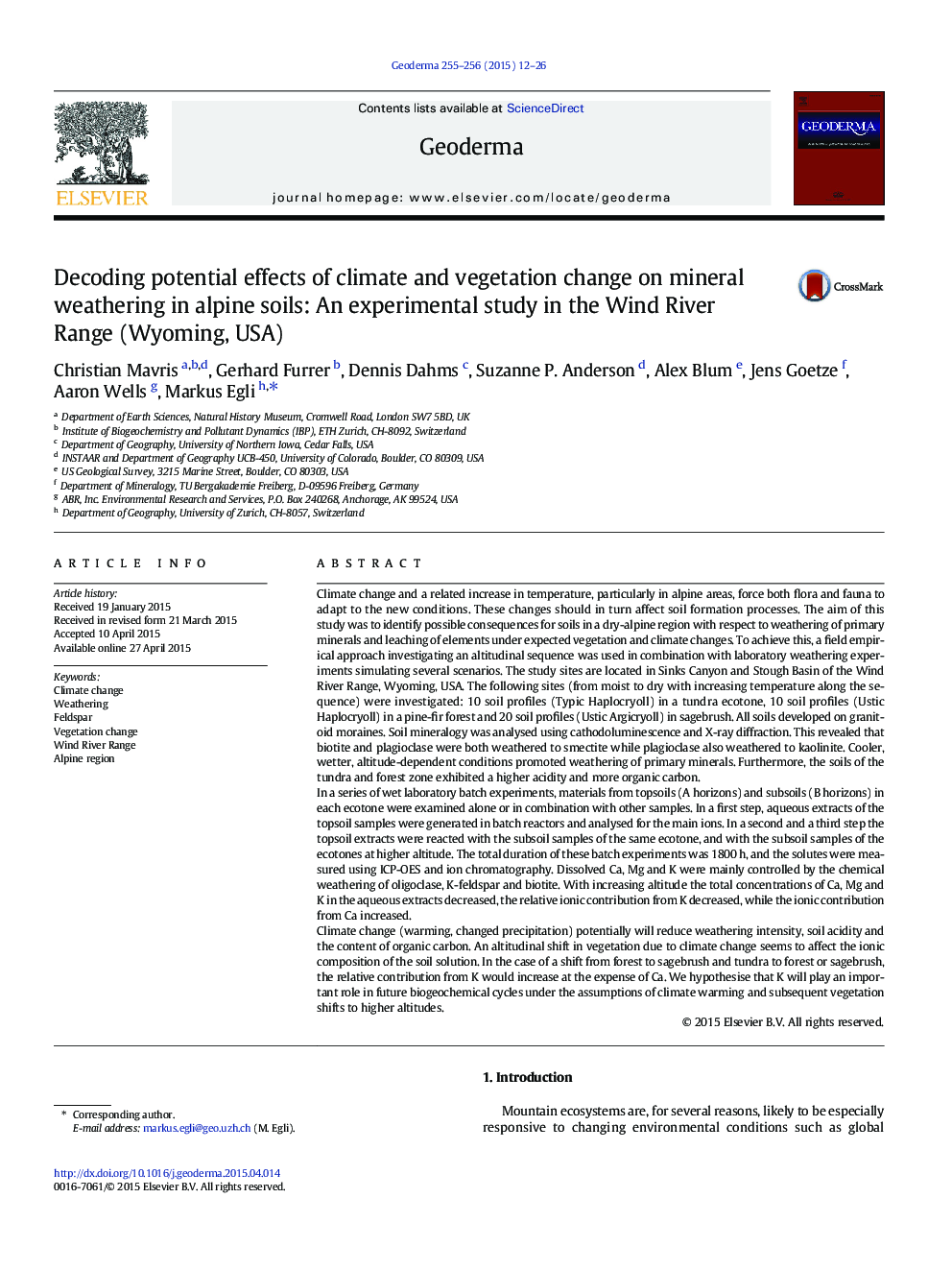| کد مقاله | کد نشریه | سال انتشار | مقاله انگلیسی | نسخه تمام متن |
|---|---|---|---|---|
| 4573141 | 1629458 | 2015 | 15 صفحه PDF | دانلود رایگان |
• An empirical and experimental approach was used to model vegetation change on soils.
• Cooler, wetter, altitude-dependent conditions promoted weathering.
• Dissolved Ca, Mg and K are controlled by oligoclase, K-feldspar and biotite.
• A shift in vegetation affects the ionic composition but not the ionic load of the soil solution.
• With climate warming, the proportion of soluble K increases at the expense of Ca.
Climate change and a related increase in temperature, particularly in alpine areas, force both flora and fauna to adapt to the new conditions. These changes should in turn affect soil formation processes. The aim of this study was to identify possible consequences for soils in a dry-alpine region with respect to weathering of primary minerals and leaching of elements under expected vegetation and climate changes. To achieve this, a field empirical approach investigating an altitudinal sequence was used in combination with laboratory weathering experiments simulating several scenarios. The study sites are located in Sinks Canyon and Stough Basin of the Wind River Range, Wyoming, USA. The following sites (from moist to dry with increasing temperature along the sequence) were investigated: 10 soil profiles (Typic Haplocryoll) in a tundra ecotone, 10 soil profiles (Ustic Haplocryoll) in a pine-fir forest and 20 soil profiles (Ustic Argicryoll) in sagebrush. All soils developed on granitoid moraines. Soil mineralogy was analysed using cathodoluminescence and X-ray diffraction. This revealed that biotite and plagioclase were both weathered to smectite while plagioclase also weathered to kaolinite. Cooler, wetter, altitude-dependent conditions promoted weathering of primary minerals. Furthermore, the soils of the tundra and forest zone exhibited a higher acidity and more organic carbon.In a series of wet laboratory batch experiments, materials from topsoils (A horizons) and subsoils (B horizons) in each ecotone were examined alone or in combination with other samples. In a first step, aqueous extracts of the topsoil samples were generated in batch reactors and analysed for the main ions. In a second and a third step the topsoil extracts were reacted with the subsoil samples of the same ecotone, and with the subsoil samples of the ecotones at higher altitude. The total duration of these batch experiments was 1800 h, and the solutes were measured using ICP-OES and ion chromatography. Dissolved Ca, Mg and K were mainly controlled by the chemical weathering of oligoclase, K-feldspar and biotite. With increasing altitude the total concentrations of Ca, Mg and K in the aqueous extracts decreased, the relative ionic contribution from K decreased, while the ionic contribution from Ca increased.Climate change (warming, changed precipitation) potentially will reduce weathering intensity, soil acidity and the content of organic carbon. An altitudinal shift in vegetation due to climate change seems to affect the ionic composition of the soil solution. In the case of a shift from forest to sagebrush and tundra to forest or sagebrush, the relative contribution from K would increase at the expense of Ca. We hypothesise that K will play an important role in future biogeochemical cycles under the assumptions of climate warming and subsequent vegetation shifts to higher altitudes.
Journal: Geoderma - Volumes 255–256, October 2015, Pages 12–26
